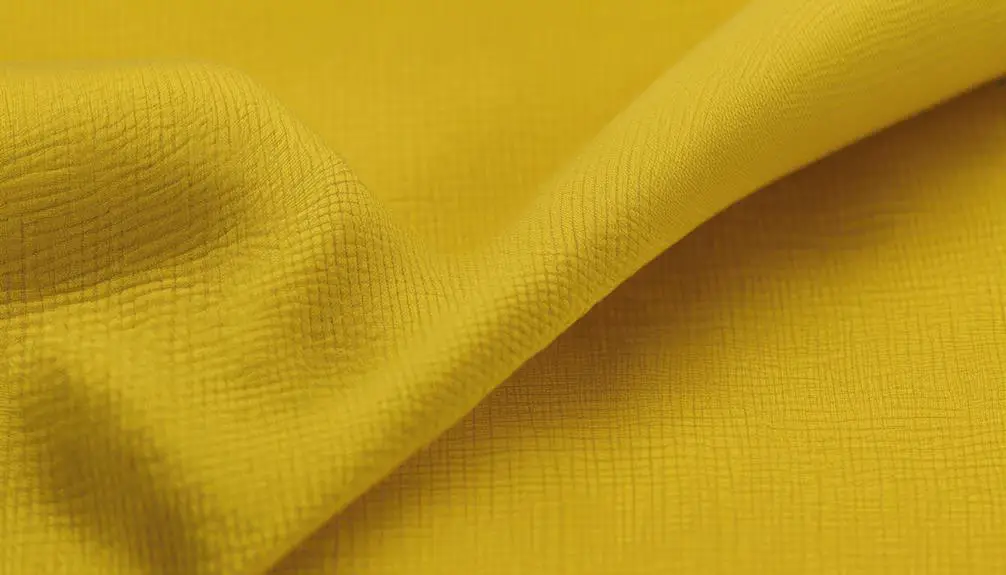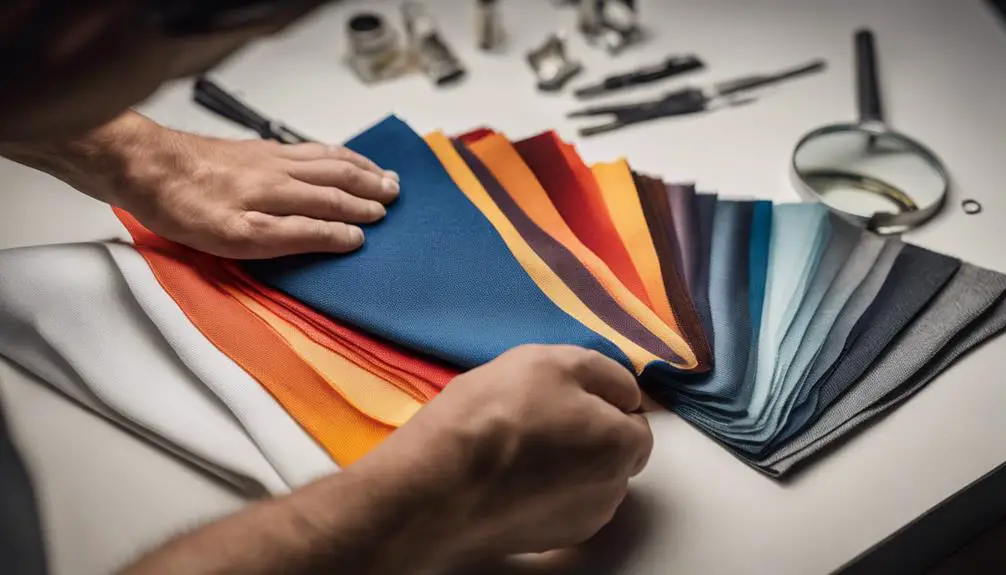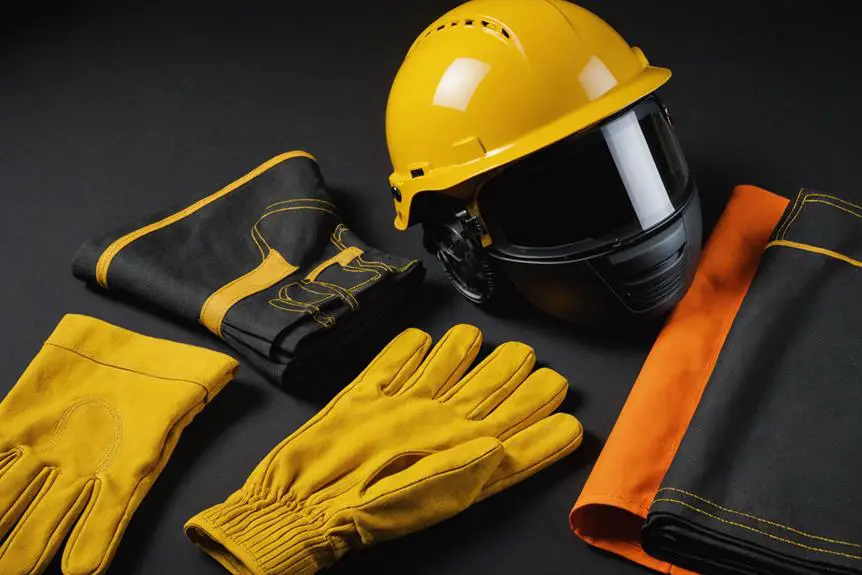When you're trying to identify Nomex fabric, it's important to start with a few key steps. First, check the label for any compliance with safety standards like NFPA or ASTM. You might also want to perform a burn test, since Nomex has unique flame-resistant properties. Additionally, look for specific characteristics like a softer texture and lightweight feel. But how can you confirm that you're not mistaking it for something else? Let's explore some effective techniques that can help you make a definitive identification.
Overview of Nomex Fabric

Nomex fabric, developed by DuPont over 50 years ago, stands out for its unique ability to resist flames and high temperatures. Isn't that cool? This flame-resistant fabric is made from special meta-aramid fibers that don't burn, melt, or drip when they're exposed to fire. Imagine the peace of mind you'd have knowing you're wearing protective clothing that can handle extreme heat—up to 370°C (700°F)! That's like having a superhero suit for your job.
When you're in a situation where every second counts, Nomex gives you those critical moments to escape. Plus, it's not just about fire protection; this fabric also keeps you comfortable. It has moisture-wicking properties that draw sweat away from your skin, helping to reduce the risk of heat stress. No one wants to feel like a soggy sponge while working in high-heat environments, right?
You'll find Nomex fabric in all sorts of industries, like oil and gas, firefighting, military, and aerospace. It's versatile and reliable, ensuring safety in some of the most hazardous working conditions. There are different types too, like Nomex IIIA, which offers flash fire protection, and Nomex MHP, designed for arc flash safety.
Key Characteristics
When it comes to identifying Nomex fabric, several key characteristics set it apart from other materials. First off, Nomex fabric is made from inherently fire-resistant meta-aramid fibers. This means it swells and forms a protective char when exposed to heat. Talk about safety! This unique feature makes it a popular choice for flame-resistant fabrics used in personal protective equipment.
You'll also notice the fabric's soft texture and lightweight feel. It's super comfy to wear, especially in high-risk environments where comfort is key. Plus, Nomex has fantastic moisture-wicking capabilities. That means it keeps your skin dry, helping to reduce heat stress during those long, intense days on the job. Who wouldn't want that?
When you're trying to identify Nomex fabric, keep an eye out for labels that indicate compliance with safety standards like NFPA and ASTM. These labels are your best friends! They'll help confirm the fabric's fire-resistant qualities. You might also see details about the fiber content, which can give you a clue that you're dealing with Nomex.
Lastly, remember that Nomex comes in various types, like Nomex IIIA and Nomex MHP. Each type has its specific properties designed to tackle different hazards, whether you work in oil and gas, firefighting, or electrical work. So, if you're in the market for protection, Nomex fabric is definitely a contender!
Identification Techniques

Identifying Nomex fabric can be straightforward if you know what to look for. This flame-resistant material is often used in protective clothing, and with a few simple techniques, you can spot it easily. Here's a handy list to help you out:
- Check the Label: Look for labels that mention safety standards like NFPA or ASTM. These are often associated with Nomex fabrics.
- Perform a Burn Test: If you're feeling adventurous, do a burn test. Nomex will self-extinguish when exposed to flames, while other materials might keep burning. Just make sure you do this safely!
- Inspect Fiber Content: Take a close look at the fabric. Nomex is made from meta-aramid fibers. If you see a high percentage of aramid fibers, you're likely dealing with Nomex.
- Visual Characteristics: Notice the texture—it's usually softer compared to other flame-resistant fabrics. You might even find it feels a bit nicer than those stiff, scratchy alternatives.
Keep in mind that Nomex can withstand heat up to 370°C (700°F). If the fabric starts melting or degrading at lower temperatures, it's probably not Nomex.
Compliance and Certification
Understanding compliance and certification is essential for anyone working with flame-resistant fabrics like Nomex. You might be wondering, why is this so important? Well, it's all about safety! Nomex fabrics need to meet specific safety standards, such as those set by the NFPA and ASTM, to guarantee they're truly flame-resistant. If you're using these fabrics, you want to be sure they'll protect you when it counts.
When you look at Nomex garments, check for certification labels. These labels aren't just for show! They indicate that the fabric has been tested and meets performance standards, including how many washes it can handle while still keeping its FR properties intact. In Europe, it gets even more serious with EN standards, which require tons of testing and documentation.
But remember, just because a fabric claims to be flame-resistant doesn't mean it is. Mislabeling can lead to legal penalties and, more importantly, safety risks! That's why you should always look for verified certifications from trusted testing bodies.
Regular testing is key, too. It guarantees that Nomex fabrics keep meeting safety regulations over time, even after you've washed them a bunch. So, keep an eye on compliance and certification! It's not just a bunch of red tape; it's your protection. Don't you want to feel safe and secure while you work? Absolutely!
Common Applications

Nomex fabric finds its way into a variety of critical applications, primarily due to its outstanding flame-resistant properties. You might be surprised by just how many industries rely on this amazing material! Whether you're a firefighter, a race car driver, or working in the oil and gas sector, Nomex has got your back when it comes to protection. Here are some common applications:
- Firefighting Gear: Firefighters wear Nomex in their turnout gear and hoods, providing essential protection against extreme heat and flames. It's a real lifesaver!
- Motorsport Apparel: In the world of racing, Nomex is used in suits that shield drivers from high temperatures and flash fires. Talk about a need for speed and safety!
- Military Uniforms: The military uses Nomex in uniforms and flight suits, ensuring personnel are safe from thermal hazards during combat and aviation missions. It's like a superhero cape, but for soldiers!
- Electrical Utility Clothing: Workers handling energized electrical equipment need protection too. Nomex offers arc flash protection, keeping them safe in hazardous conditions.
Frequently Asked Questions
How to Tell if Clothes Are FR?
To tell if clothes are flame-resistant (FR), check their fabric characteristics first. Look for safety certifications like NFPA or ASTM labels; they're your best friends! Next, see if they mention specific fibers, like aramid. You can even do a little burn test—just a small piece! Finally, check the maintenance guidelines for wash limits. Remember, the right gear keeps you safe, especially in tough usage environments. Isn't that reassuring?
How to Tell if Fabric Is Fire Retardant?
Want to know if that fabric's fire retardant? Start by checking for fire safety standards labels—those are your first clue. Then, try some fabric testing methods like a burn test; if it self-extinguishes, you're golden! Also, peek at the chemical composition analysis. Fabrics with a high flame resistance rating usually contain materials like Nomex or Kevlar. It's all about keeping you safe while looking good—who doesn't want that?
What Is the Difference Between Nomex and Fr?
So, you're curious about Nomex vs. FR fabrics? Well, Nomex properties are pretty special! It's flame-resistant without needing chemicals, unlike many other FR materials. You'll find Nomex applications in firefighting and aerospace, where safety's key. Plus, it's often compared to Kevlar for strength. When it comes to Nomex care, just wash it like normal, and you're good! Isn't it cool how durable it is? It really gives you peace of mind during risky jobs!
What Is the Code for Nomex?
So, you're curious about the code for Nomex? Well, it's all about those cool Nomex properties! Think flame resistance and durability. When you explore Nomex applications, you'll see it's used in everything from firefighting gear to race suits. Did you know Nomex has a rich history, too? And if you're comparing Nomex vs Kevlar, you'll find each has its perks. Just remember, knowing the code helps you choose the right one!
Conclusion
So, there you have it! Identifying Nomex fabric isn't just about the label; it's about using your senses too! Remember to check for that self-extinguishing burn test, feel the lightweight texture, and look for those aramid fibers. Whether you're a firefighter or just curious, knowing how to spot Nomex can keep you safe. Isn't it cool to uncover the secrets of fabric? Go ahead, give it a try, and impress your friends with your new fabric detective skills!





Central bank digital currency news